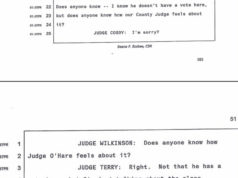Last week, as the Weekly was putting its “Best of 2007” issue to bed (a chore not unlike getting an 800-lb. gorilla to brush its teeth and change into its jammies), word came that Peter Feresten, Fort Worth’s photographer par excellence, had died of complications from lung cancer.
For more than three decades, Feresten, a doctor’s son from Massachusetts, chronicled this town’s less-than-famous communities and rituals – in many cases, documenting ways of life here just as they were disappearing. And so there was a rare mix of folks at his funeral on Sept. 22 – students, teachers, art collectors, bikers, people from all parts of town.
Byrd Williams IV, a friend and colleague for all of those decades, said Feresten worked almost until the end. Photography – and teaching photography – were the ruling passions of his life. “He taught up until the end of the semester in May” at Tarrant County College “then went into the hospital and never came out,” except to go home to die, Williams said. That was the way Feresten always had been – coming back quickly after first one kidney transplant and then another, then from having half a lung removed, always coming back to teaching and shooting.
“Peter was one of those teachers … he had a nurturing commitment to his students that he didn’t always lend to his colleagues,” Williams said of his gruff friend.
Another of Feresten’s defining characteristics, Williams said, was that he never cared about wealth or recognition. “He had lots of opportunities for his career to move to the next lane,” Williams said. “He would cooperate only as long as it was not in the way of the work, only until he had to compromise.”
Feresten’s arrival in Fort Worth changed the art and practice of photography here. “His knowledge, his commitment was so big, it kind of stood the community on its ear,” Williams said. “Suddenly there was a new standard. I had to measure my work by Peter, not what I’d measured it by before.” His friend had an anthropologist’s drive to document the fringes of society, the parts in danger of fading away – rituals in black churches, blues players, craftspeople whose art was being replaced by factories, bikers, the pre-Disney world of the Stockyards. “Peter was sensitive to that sort of change and tried in a very honest way to put it down for posterity,” Williams said. “He understood better than anyone I know what it means to be a documentary photographer.” The Weekly featured Feresten in an Aug. 15, 2002, cover story and published several of these images.
“It was the end of an era when he died,” Williams said. “It marks a place.”
A Race to the Polls
A stretch of University Drive just north of downtown is six lanes divided by a median, subconsciously lulling motorists into driving as they would on other wide, divided roadways – maybe not at the 60 mph cruising speed of an interstate, but 45 mph would certainly seem reasonable. Reasonable, yes; legal, no. The speed limit on University is 35 freaking miles per hour, and motorcycle cops hide in a cemetery driveway to pop unwary drivers with costly reminders of that. It’s not about public safety, it’s about raising money – kind of like being panhandled by your own government.
A web site cataloguing speed traps across the country has named 18 of them in Fort Worth (they missed the one on University). Check it out at www.speedtrap.org. Static’s concern in this, of course, is purely one of the public good – there’s no personal bitterness here about any unfair ticket requiring the hiring of a lawyer to keep insurance rates from going up.
Why would you even have to ask?











